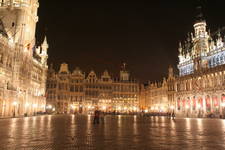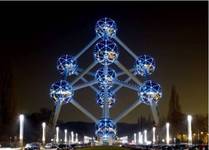|
|
|
|
BrusselsGeographically, Brussels is ideally situated: thanks to high-speed trains such as Thalys and Eurostar, Paris (1h20), London (1h50), Cologne (2h20) and Amsterdam (2h40) are just around the corner. Capital of EuropeBrussels is the federal capital of Belgium. It is also home to many national and foreign companies, the main Belgian political institutions and many European institutions (European Commission, European Parliament, Council of Ministers). Brussels is both the political and administrative centre of Europe. Art & ArchitectureThe Grand'Place - a UNESCO World Heritage Site: The impressive main square with the town hall and surrounding alleyways and old houses is one of the finest in the world. Described by Victor Hugo as "the most beautiful square in Europe", it is a stunning example of 15th century (Hotel de Ville) and 17th century (the guild houses) architecture.
The Atomium: The 103-metre representation of an iron crystal built for Expo '58, is a classic piece of 20th century design. Recently restored in preparation for its 50th birthday, it's a great place to visit for panoramic views of the city. Royal Museums of Fine Arts of Belgium: The Royal Museums of Fine Arts of Belgium hold some 20,000 paintings, sculptures and drawings. They consist of the Museum of Ancient Art (XV - XVII century), the Museum of Modern Art (XIX - XX century), the Wiertz Museum and the Meunier Museum.
BOZAR Palace of Fine Arts: An Art Deco masterpiece by Victor Horta, the Palace of Fine Arts is one of the jewels of Belgium's cultural and architectural heritage. Musical Instruments Museum Old England Building: While the entrance is Art Nouveau, the rest of the building is in perfect harmony with the neoclassical style of the Place Royale. The museum's extraordinary collections in particular stand out. Belgian Centre for Comic Strip Art: This is the Kingdom of the Smurfs, Tintin, Lucky Luke, Spirou, Gaston Lagaffe, Spike and Suzy and plenty of other paper heroes! One of the major Brussels tourist attractions and a superb example of Art Nouveau architecture. Art Nouveau in BrusselsAt the turn of the 20th century, Brussels went through a period of unrivalled effervescence. The Art Nouveau style burst onto the scene in 1893 courtesy of two architects, Victor Horta and Paul Hankar: the Tassel House and Hankar's own private home were the first tokens of a new aesthetic. GastronomyWith more Michelin stars per head of population than anywhere else in the world, Brussels is a great place to set aside all diet plans and indulge. DesignBrussels always has been and always will be a multicultural city. It is the place to be for talented and creative designers: it is an exuberant and surrealist place to live and offers a dynamic working environment. Before they completely fell under Brussels' spell, many designers chose to attend internationally renowned schools such as La Cambre, or for interior design, the Hogeschool Sint- Lukas, the CAD, the Royal Academy for Fine Arts of Brussels or Saint-Luc. © Office de Promotion du Tourisme de Wallonie et de Bruxelles asbl For more information http://www.opt.be/ |
|||||||||||



